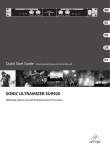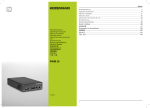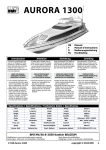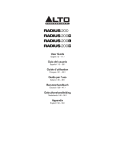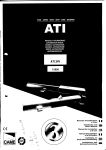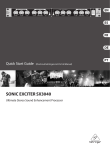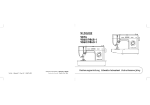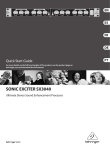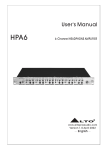Download USER GUIDE GUÍA DEL USUARIO GUIDE D
Transcript
HPA6 USER GUIDE ENGLISH ( 2 – 7 ) GUÍA DEL USUARIO ESPAÑOL ( 8 – 14 ) GUIDE D’UTILISATION FRANÇAIS ( 15 – 20 ) GUIDA PER L'USO ITALIANO ( 21 – 26 ) BENUTZERHANDBUCH DEUTSCH ( 27 – 32 ) GEBRUIKERSHANDLEIDING NEDERLANDS ( 33 – 38 ) USER GUIDE (ENGLISH) BOX CONTENTS • HPA6 • Power Cable • User Guide • Safety Instructions & Warranty Information Booklet 1. Make sure all items listed in the Box Contents are included in the box. 2. READ THE SAFETY INSTRUCTION BOOKLET BEFORE USING THE PRODUCT. 3. Switch everything on in the following order: • audio input sources (i.e. instruments, CD/MP3 players) • HPA6 • speakers/amps 4. When turning off, always reverse this operation: • speakers/amps • HPA6 • last, any input sources CAUTION! Permanent hearing loss may be caused by exposure to extremely high noise levels. The U.S. Government's Occupational Safety and Health Administration (OSHA) has specified permissible exposures to certain noise levels. According to OSHA, exposure to high sound pressure levels (SPL) in excess of these limits may result in hearing loss. When using equipment capable of generating high SPL, use hearing protection while such equipment is under operation. HOURS PER DAY 8 6 4 3 2 1.5 1 .50 .25 or less SPL 90 92 95 97 100 102 105 110 115 EXAMPLE Small gig Train Subway train High level desktop monitors Classical music concert Riveting machine Machine factory Airport Rock concert INTRODUCTION Thanks for purchasing the Alto Professional HPA6! HPA6 is a universal, multi-purpose mixer and headphone amplifier for rehearsal, studio, or stage. Perfect for headphones, in-ear monitors, or personal monitor mixing, HPA6 features six independent high-power stereo amplifiers in one compact rack unit that delivers maximum audio quality, even at very high or very low volume levels; HPA6 has a minimized circuitry path which means there's less "stuff" for your signal to pass through, keeping your sound clear and crisp. • • • • • • • • • Manufactured under QS9000 certified quality system Six independent high-powered headphone amplifiers in a compact, 1RU size Supplies six fully independent mixes for up to 18 pairs of headphones Stereo Aux Input on each channel with level adjustments Additional Direct Input on front panel to mix in additional sources Four-segment LED on each channel for easy visual monitoring Mono and Left/Right Mutes per channel for two mono mixes per channel High-quality components and exceptionally rugged construction Servo-balanced, gold-plated XLR and 1/4" TRS connectors 2 FRONT PANEL CONTROLS 1. Direct input - Feeds an external audio source directly into the main signal path. 2. Input gain control - Controls the signal level going to the Main or Direct Inputs. 3. Input level meter - Displays the signal level coming from Main/Direct Inputs. For the best quality of input signal, the LED should range from +6 to +18 dBu. If the Clip LED (in the Output Level Meter) is always on, reduce the input level using the input gain control. 4. Aux input - Provides a separate stereo input signal which can be mixed with the Main/Direct Input signal. 5. L mute switch - Mutes the left input signal. 6. R mute switch - Mutes the right input signal. 7. Mode switch - Switches the operational mode between mono and stereo. 8. Mono LED - This LED lights up when the unit is in mono mode. When the LED is off, the unit is in stereo mode. 9. Headphone output - 1/4" TRS phone jack used to output the signal of the individual channel. There are also 12 additional headphone outputs (two for each channel) on the rear panel. 10. Balance control - Sets the amount of the signal coming from Aux Input and Main/Direct Input. When the Aux Input is not in use, it will regulate the stereo imaging of the input signal. When a signal is fed into the Aux Input, the balance control will regulate the ratio of the Main Input (or Direct In) and the Aux Input signals. 11. Output gain control - Adjusts the output level of the individual channel. 12. Output level meter - Displays the output signal level. If the Clip LED lights up, turn down the input gain control and/or the individual output gain control to avoid distortion. 12 5 3 1 2 6 10 11 9 8 7 4 REAR PANEL CONTROLS 16 13 14 6 TIP: L- CHANNEL RING: R- CHANNEL MIN. LOAD 100 OHMS 5 4 3 2 1 MAIN OUTPUT RIGHT MAIN OUTPUT LEFT TIP/PIN 2 RING/PIN 3 SLEEVE/PIN 1 6 5 4 3 2 15 MAIN INPUT RIGHT MAIN INPUT LEFT TIP/PIN 2 RING/PIN 3 SLEEVE/PIN 1 1 HEADPHONE OUT 17 13. Fuse holder - If the fuse blows, replace it with a fuse of the same type. 14. Power Connector - Use the included power cable to connect this connector to a power source. Please check the voltage accepted by the unit and the voltage available from your power source before connecting it. 15. Main input connectors - Balanced 1/4" TRS and XLR connectors used to input the stereo signal. 16. Main output connectors - Balanced 1/4" TRS and XLR connectors used to output the main signal. Use these connectors to link several headphone amplifiers together. 17. Headphone out (1-12) - These are 12 additional headphone outputs (two for every channel) wired in parallel with the output available on the front panel. 3 APPLICATIONS USING THE MAIN INPUT CONNECTORS 1. 2. 3. 4. Connect your source to the rear panel Main Input connectors on HPA6. Set the Input Gain (Main section) and the Balance control (Channel section) on center position. Set the Output gain of each channel all the way down. Check the input level meter for optimal signal. Connect headphones to HPA6 and start to raise the output gain of each channel to the desired listening volume. Main Outputs USING THE AUX INPUTS You can also play back a signal to feed in a vocal microphone and then connect a mixer’s aux send to HPA6’s Aux Input. Use the Balance control to give the vocalist the desired mix between the voice and the playback signal. Then, adjust the Output Gain control to regulate the overall desired volume. Main Out Aux Send 4 Through the Aux Inputs, you can use the six channels of HPA6 independently to give individual mixes to six different musicians. Connect the Aux Sends or Subgroup outputs directly to the Aux Input of HPA6. Then rotate the Balance control on your HPA6 fully to the left. This will route only the AUX IN signal to the headphones. Aux Send 1 Aux Send 2 Aux Send 3 Aux Send 4 Aux Send 5 Aux Send 6 USING MULTIPLE HEADPHONES ON THE SAME CHANNEL Each channel provides three headphone outputs. These jacks are all connected in parallel. For best results, please note the impedance information: • • • When connecting one headphone to each channel, the minimum impedance of the headphone should be 100 ohms. When connecting two headphones to each channel, the minimum impedance of each headphone should be 200 ohms. When connecting three headphones to each channel, the minimum impedance of each headphone should be 300 ohms. INSTALLATION AND CONNECTION Read the following section carefully. Not paying attention to the input signal level, to the routing of the signal and to the assignment of the signal will result in unwanted distortion, a corrupted signal or no sound at all. Power Connection Use the same fuse as marked on the fuse holder near the power connector. Connect HPA6 to a standard power outlet using the enclosed power cable. Audio Connection The HPA6 uses balanced XLR and 1/4" TRS phones jack. It can be connected to other units in a variety of ways to support a vast range of applications without experiencing a signal loss. 5 Wiring Configuration XLR servo connectors can be wired in balanced and unbalanced modes. Please wire your systems according to the following examples: • 1/4" Phone jack Tip Sleeve TS Type Unbalanced • Tip Sleeve Ring Sleeve TRS Type Balanced TRS Type Unbalanced XLR connector Pin2 (+)(+) Pin2 Pin2 (+) Pin3 Pin3 (-)(-) Pin3 (-) (-) Pin3 (Linked to Pin1 manually (Linked to Pin1 manually Pin1 Pin1 Pin1 XLR Type Unbalanced • Tip Ring XLR Type Balanced Balanced Sleeve Ring Tip Tip Ring Sleeve Tip Ring Sleeve 1 2 3 Tip Ring Sleeve Tip Ring Sleeve 6 • Unbalanced Tip Ring Sleeve Tip Ring Sleeve Tip Sleeve Tip Sleeve Tip Sleeve Tip Ring Sleeve Sleeve Tip 1 2 3 Center Tip Sleeve Tip Sleeve Tip Ring Sleeve Center Screen Tip Ring Sleeve Tip Sleeve Sleeve Ring Tip Tip Sleeve Tip Ring Sleeve 1 2 3 Tip Ring Sleeve 7 1 2 3 1 2 3 Screen Center Screen 1 2 3 GUÍA DEL USUARIO (ESPAÑOL) CONTENIDO DE LA CAJA • HPA6 • Cable de alimentación • Guía del usuario • Folleto de instrucciones de seguridad e información sobre la garantía 1. Asegúrese de que todos los artículos indicados en “Contenido de la caja" estén incluidos en la caja. 2. LEA EL FOLLETO DE INSTRUCCIONES DE SEGURIDAD ANTES DE UTILIZAR EL PRODUCTO. 3. Encienda todo en el siguiente orden: • fuentes de entrada de audio (por ejemplo instrumentos o reproductores de CD/MP3) • HPA6 • altavoces/amplificadores 4. Al apagar, realice siempre esta operación en forma inversa: • altavoces/amplificadores • HPA6 • por último, todas las fuentes de entrada PRECAUCIÓN La exposición a niveles muy altos de ruido puede causar pérdidas auditivas permanentes. La Administración de Seguridad y Salud Ocupacional del gobierno de EE.UU. (OSHA) ha especificado los niveles de exposición permisibles a ciertos niveles de ruido. Según la OSHA, la exposición a niveles de presión sonora (SPL) elevados que excedan estos límites puede causar pérdidas auditivas. Cuando utilice equipos capaces de generar SPL elevados, use protecciones auditivas mientras dichos equipos están en funcionamiento. HORAS DIARIAS 8 6 4 3 2 1.5 1 SPL 90 92 95 97 100 102 105 EJEMPLO Música de bajo volumen Tren Tren subterráneo Monitores de escritorio de alto nivel Concierto de música clásica Remachadora Máquina fabril 0.50 0.25 o menos 110 115 Aeropuerto Concierto de rock INTRODUCCIÓN ¡Gracias por adquirir el HPA6 Alto Professional! El HPA6 es un mezclador y amplificador para auriculares universal multipropósito para los ensayos, el estudio o el escenario. Ideal para auriculares, monitores en oído o mezcla para monitor personal, el HPA6 ofrece seis amplificadores estéreo de alta potencia independientes en un rack compacto, que brindan máxima calidad de audio, incluso a niveles de volumen muy altos o muy bajos y una circuitería minimizada que significa que su señal debe pasar por menos "cosas", manteniendo así el sonido claro y nítido. • • • • • • • • • Fabricado según el sistema de certificación de calidad QS9000 Seis amplificadores para auriculares de alta potencia independientes en el tamaño compacto 1RU (1 unidad de rack) Suministra seis mezclas totalmente independientes para hasta 18 pares de auriculares Entrada auxiliar estéreo en cada canal con ajustes de nivel Entrada directa adicional en el panel frontal para mezclar fuentes adicionales LED de cuatro segmentos en cada canal que facilitan el monitoreo visual Silenciamientos mono e izquierdo/derecho por canal para lograr dos mezclas mono por canal Componentes de alta calidad y construcción excepcionalmente robusta Conectores XLR y TRS de 1/4 pulg., servobalanceados y enchapados en oro 8 CONTROLES DEL PANEL FRONTAL 1. 2. 3. Entrada directa- Aplica una fuente de audio externa directamente a la ruta de señal principal. Control de ganancia de entrada - Controla el nivel de señal aplicada a las entradas Main (Principal) o Direct (Directa). Medidor de nivel de entrada Muestra el nivel de señal proveniente de las entradas Main/Direct (Principal/Directa). Para lograr la mejor calidad de la señal de entrada, el LED debe variar entre +6 y +18 dBu. Si el LED Clip (Recorte) (del medidor de nivel de salida) está siempre encendido, reduzca el nivel de entrada mediante el control de ganancia de entrada. Entrada auxiliar (Aux In) - Proporciona una señal de entrada estéreo independiente que se puede mezclar con la señal de entrada principal/directa Interruptor de silenciamiento izquierdo - Silencia la señal de entrada izquierda. Interruptor de silenciamiento derecho - Silencia la señal de entrada derecha. Conmutador de modo - Cambia el modo de funcionamiento entre mono y estéreo. LED Mono - Este LED se enciende cuando la unidad está en modo mono. Cuando el LED está apagado, la unidad está en modo estéreo. Salida para auriculares - Conector fonográfico TRS de 1/4 pulg. usado para la salida de la señal del canal individual. Hay también 12 salidas para auriculares adicionales (dos para cada canal) en el panel trasero. Control de balance - Fija la magnitud de la señal proveniente de la entrada Aux In y la entrada principal/directa. Cuando la entrada Aux In no está en uso, regula la imagen estéreo de la señal de entrada. Cuando se aplica una señal a la entrada Aux In, el control de balance regula la relación entre la entrada principal (o DIRECT IN) y las señales de entrada auxiliares. Control de ganancia de salida - Permite ajustar el nivel de salida del canal individual. Medidor de nivel de salida - Muestra el nivel de la señal de salida. Si se enciende el LED Clip (Recorte), reduzca con el control la ganancia de entrada y/o la ganancia de salida del canal individual a fin de evitar la distorsión. 12 1 4. 5. 6. 7. 8. 9. 10. 11. 12. 5 3 9 2 6 10 11 8 7 4 9 CONTROLES DEL PANEL TRASERO 16 13 14 6 TIP: L- CHANNEL RING: R- CHANNEL MIN. LOAD 100 OHMS 5 4 3 2 1 MAIN OUTPUT RIGHT MAIN OUTPUT LEFT TIP/PIN 2 RING/PIN 3 SLEEVE/PIN 1 6 5 4 3 2 15 MAIN INPUT RIGHT MAIN INPUT LEFT TIP/PIN 2 RING/PIN 3 SLEEVE/PIN 1 1 HEADPHONE OUT 17 13. 14. 15. 16. 17. Portafusible - Si se quema el fusible, reemplácelo por otro del mismo tipo. Conector de alimentación - Use el cable de alimentación incluido para conectar este conector al suministro eléctrico. Antes de conectarlo, compruebe el voltaje aceptado por la unidad y el disponible en su red de suministro. Conectores de la entrada principal - Conectores XLR y TRS de 1/4 pulg. balanceados usados para aplicar la señal de entrada estéreo. Conectores de la salida principal - Conectores XLR y TRS de 1/4 pulg. balanceados usados para la salida de la señal principal Use estos conectores para conectar varios amplificadores para auriculares. Salida para auriculares (1-12) - Son 12 salidas para auriculares adicionales (dos para cada canal) cableadas en paralelo con la salida disponible en el panel frontal. APLICACIONES CÓMO USAR LOS CONECTORES DE LA ENTRADA PRINCIPAL 1. 2. 3. 4. Conecte su fuente a los conectores Main Input (Entrada principal) del panel trasero del HPA6. Ajuste los controles Input Gain (Ganancia de entrada) de la sección Main (Principal) y Balanced (Balance) de la sección Channel (Canal) a la posición central. Ajuste OUTPUT GAIN (Ganancia de salida) de cada canal al mínimo. Compruebe el medidor de nivel de entrada para obtener la señal óptima. Conecte los auriculares al HPA6 y comience a aumentar la ganancia de salida de cada canal al nivel de escucha deseado. Salidas principales 10 CÓMO USAR LAS ENTRADAS AUXILIARES Es posible también reproducir una señal para aplicar a un micrófono vocal y luego conectar el envío auxiliar de un mezclador a la entrada Aux In del HPA6. Use el control Balance para dar al vocalista la mezcla deseada entre la voz y la señal reproducida. A continuación, ajuste el control OUTPUT GAIN para regular el volumen general deseado. Salida principal Envío auxiliar A través de las entradas Aux, es posible usar los seis canales del HPA6 independientemente para brindar mezclas individuales a seis músicos diferentes. Conecte las salidas de envíos auxiliares o de subgrupo directamente a la entrada Aux In del HPA6. A continuación gire el control Balance del HPA6 totalmente a la izquierda. De esta forma, se aplicará sólo la señal AUX IN a los auriculares. Envío Aux 1 Envío Aux 2 Envío Aux 3 11 Envío Aux 4 Envío Aux 5 Envío Aux 6 CÓMO USAR VARIOS AURICULARES EN EL MISMO CANAL Cada canal proporciona tres salidas para auriculares. Estos conectores hembra están todos conectados en paralelo. Para lograr los mejores resultados, tenga en cuenta la información de impedancia: • • • Cuando conecta un auricular a cada canal, la impedancia mínima del auricular debe ser 100 ohmios. Cuando conecta dos auriculares a cada canal, la impedancia mínima de cada auricular debe ser 200 ohmios. Cuando conecta tres auriculares a cada canal, la impedancia mínima de cada auricular debe ser 300 ohmios. INSTALACIÓN Y CONEXIÓN Lea atentamente la sección siguiente. Si no presta atención al nivel de señal de entrada, al encaminamiento y la asignación de la señal, se producirá una distorsión no deseada, una señal corrupta o ningún sonido en absoluto. Conexión de la alimentación Use el mismo fusible marcado en el portafusible cercano al conector de alimentación. Conecte el HPA6 a un tomacorriente estándar usando el cable de alimentación incluido. Conexión de audio El HPA6 usa conectores hembra fonográficos TRS de 1/4 pulg. y XLR balanceados. Puede conectarse a otras unidades en una variedad de maneras para soportar una vasta gama de aplicaciones sin experimentar pérdidas de señal. 12 Configuración del cableado Los conectores servo XLR se pueden cablear en modos balanceado y no balanceado. Cablee sus sistemas de acuerdo a los siguientes ejemplos: • Conector fonográfico de 1/4 pulg. Punta Manguito Tipo TS no balanceado • Punta Manguito Nuca Manguito Tipo TRS balanceado Tipo TRS no balanceado Conector XLR Pin 2 (+) Pin2(+) Pin 1 Pin 2 (+) PinPin 3 (-) 3 (-) PinPin3 3 (-)(-) (Conectado al pin 1 1 (Conectado al pin manualmente manualmente) Pin Pin11 Tipo XLR no balanceado • Punta Nuca Tipo XLR balanceado Balanceado Manguito Nuca Punta Punta Nuca Manguito Punta Nuca Manguito 1 2 3 Punta Nuca Manguito Punta Nuca Manguito 13 • No balanceado Punta Nuca Manguito Punta Nuca Manguito Punta Manguito Punta manguito 1 2 3 Punta manguito Punta Nuca Manguito Punta manguito Punta Nuca Manguito Manguito Punta Manguito Nuca Punta Manguito Punta Nuca Manguito Punta Manguito Punta Nuca Manguito 1 2 3 14 1 2 3 1 2 3 Centro Malla Punta Manguito Punta Nuca Manguito Centro Malla Centro Malla 1 2 3 GUIDE D’UTILISATION (FRANÇAIS) CONTENU DE LA BOÎTE • HPA6 • Câble d'alimentation • Guide d’utilisation • Consignes de sécurité et informations concernant la garantie 1. Assurez-vous que tous les articles énumérés dans le contenu de la boîte de ce guide sont inclus dans la boîte. 2. VEUILLEZ LIRE LE LIVRET DES CONSIGNES DE SÉCURITÉ AVANT D'UTILISER LE PRODUIT. 3. Mettez tous les appareils sous tension dans l'ordre suivant : • Source d'entrée audio (p. ex., instruments, lecteurs CD/MP3) • HPA6 • Haut-parleurs/amplificateurs; 4. Pour mettre hors tension, toujours inversez l'opération : • Haut-parleurs/amplificateurs; • HPA6 • En dernier, les sources d'entrée audio. MISE EN GARDE! L'exposition aux niveaux extrêmement élevés de bruit peut causer une perte d'audition permanente. Le comité de santé et de sécurité au travail des États-Unis (OSHA) a établi des durées d'exposition acceptables pour certains niveaux de bruit. Selon la OSHA, une exposition à des niveaux de pression acoustique (NPA) au-dessus de ces limites peut avoir comme conséquence une perte d'audition. Lors de l’utilisation d’équipement capable de générer des niveaux de pression acoustique élevés, il faut prendre des mesures afin de protéger son ouïe lorsque cette unité est en fonction. HEURES PAR JOUR 8 6 4 3 2 1.5 1 NPA 90 92 95 97 100 102 105 EXEMPLE Petite salle de spectacle Train Train de métro Moniteurs de table à niveaux élevés Concert de musique classique Riveteuse Usine de fabrication .50 .25 ou moins 110 115 Aéroport Concert rock PRÉSENTATION Merci d’avoir choisi le HPA6 de Alto Professional. Le HPA6 est un amplificateur pour console de mixage et casque d’écoute multi-usage pour les répétitions, le studio d’enregistrement ou la scène. Le HPA6 convient pour les casques d’écoute, les moniteurs de scène personnels, ou le monitorage du mix et dispose de 6 amplificateurs de grande puissance stéréo indépendants en une unité de rack qui offre un maximum de qualité, même à des niveaux très élevés ou très faibles. Le HPA6 dispose d’un parcours de circuit réduit afin que le son demeure clair et net. • • • • • • • • • Système de fabrication certifiée qualité QS9000 Six amplificateurs de casque indépendants de grande puissance en une unité compacte (1RU) Fournit six mix indépendants pour jusqu’à 18 casques d’écoute Entrée auxiliaire stéréo sur chaque canal avec réglage des niveaux Entrée directe supplémentaire sur le panneau avant afin de mixer des sources additionnelles Quatre segments de DEL sur chaque canal permettent un monitorage simple et rapide Mises en sourdine mono et du canal gauche/droit pour deux mix mono par canal Composantes de grande qualité et une construction ultrarobuste Connecteurs XLR et TRS ¼ po plaqués or à symétrie électronique 15 COMMANDES DU PANNEAU AVANT 1. Entrée directe – Cette entrée permet d’insérer une source externe directement dans le trajet du signal. 2. Gain d’entrée – Ce bouton permet de régler le niveau du signal acheminé aux entrées principales et directes. 3. Vumètre du niveau d’entrée – Ce vumètre indique le niveau du signal provenant des entrées principales/directes. Pour la meilleure qualité du signal d’entrée, la DEL devrait se situer entre +6 et +18 dBu. Si la DEL d’écrêtage (dans le vumètre du niveau de sortie) est continuellement allumée, réduisez le niveau d’entrée à l’aide du bouton du gain d’entrée. 4. Entrée auxiliaire – Cette entrée permet d’ajouter un signal d’entrée stéréo séparé qui peut être mélangé avec le signal de l’entrée principale/directe. 5. Mise en sourdine gauche – Cette touche permet de mettre en sourdine le signal d’entrée gauche. 6. Mise en sourdine droite – Cette touche permet de mettre en sourdine le signal d’entrée droit. 7. Sélecteur de mode – Cette touche permet de permuter entre le mode mono et le mode stéréo. 8. DEL mono – Ce témoin s’allume lorsque l’appareil est mis en mode mono. Lorsque la DEL est éteinte, l’appareil est en mode stéréo. 9. Sortie casque d’écoute – Connecteur casque ¼ po (6,35 mm) TRS permettant l’écoute d’un canal individuel. Il y a également 12 sorties casque supplémentaires (deux pour chaque canal) sur le panneau arrière. 10. Balance – Ce bouton permet de régler la quantité du signal provenant de l’entrée auxiliaire et de l’entrée principale/directe. Lorsque l’entrée auxiliaire n’est pas utilisée, il contrôle l’image stéréoscopique du signal d’entrée. Lorsqu’un signal est acheminé à l’entrée auxiliaire, la balance contrôle le rapport entre le signal d’entrée principale (ou directe) et le signal de l’entrée auxiliaire. 11. Gain de sortie – Ce bouton permet de régler le niveau de sortie du canal individuel. 12. Vumètre du niveau de sortie – Indique le niveau de sortie du signal. Si la DEL d’écrêtage s’allume, diminuez le réglage de l’entrée de gain et/ou de la sortie de gain individuelle afin d’éviter de la distorsion. 12 2 1 6 10 11 5 3 8 7 4 9 COMMANDES DU PANNEAU ARRIÈRE 16 13 14 6 TIP: L- CHANNEL RING: R- CHANNEL MIN. LOAD 100 OHMS 5 4 3 2 1 MAIN OUTPUT RIGHT MAIN OUTPUT LEFT TIP/PIN 2 RING/PIN 3 SLEEVE/PIN 1 6 5 4 3 2 15 MAIN INPUT RIGHT MAIN INPUT LEFT TIP/PIN 2 RING/PIN 3 SLEEVE/PIN 1 1 HEADPHONE OUT 17 13. Porte-fusible – En cas de rupture, remplacez le fusible avec un de même type. 14. Connecteur d’alimentation – Branchez le câble d’alimentation inclus à cette entrée, puis l'autre extrémité à la prise secteur. Veuillez vérifier la tension acceptée par l’appareil et la tension de la prise secteur avant de brancher le câble. 15. Connecteurs d’entrée principale – Ces connecteurs symétriques ¼ po (6,35 mm) TRS et XLR permettent l’entrée d’un signal stéréo dans le trajet. 16. Connecteurs de sortie principale – Ces connecteurs symétriques ¼ po (6,35 mm) TRS et XLR permettent la sortie d’un signal stéréo. Vous pouvez utiliser ces connecteurs afin de relier plusieurs amplificateurs de casque ensemble. 17. Sortie casque (1 à 12) – Ces 12 sorties casque supplémentaires (deux pour chaque canal) câblées en parallèle avec la sortie disponible sur le paneau avant. 16 APPLICATIONS UTILISATION DES CONNECTEURS D'ENTRÉE PRINCIPALE 1. 2. 3. 4. Raccordez la source aux connecteurs de l’entrée principale sur le panneau arrière du HPA6. Réglez le gain d’entrée (section Main) et la balance (section Channel) sur la position centrale. Baissez le gain de sortie de chaque canal complètement. Vérifiez le vumètre du niveau d’entrée afin d’obtenir un signal optimal. Branchez des casques d’écoute au HPA6 et augmentez progressivement le gain de sortie de chaque canal au niveau désiré. Sorties principales UTILISATION DES ENTRÉES AUXILIAIRES Vous pouvez également faire en sorte d’acheminer un signal enregistré vers un microphone vocal, puis brancher la sortie auxiliaire d’une console de mixage à l’entrée auxiliaire du HPA6. Utilisez la balance afin de fournir au chanteur le mix désiré entre la voix et le signal enregistré. Puis, réglez le gain de sortie afin d’obtenir les niveaux généraux désirés. Sorties principales Entrée auxiliaire 17 Grâce aux entrées auxiliaires, vous pouvez utiliser les six canaux du HPA6 indépendamment afin de fournir des mix individuels à six musiciens différents. Raccordez les sorties auxiliaires ou de sous-groupe directement à l’entrée auxiliaire du HPA6. Mettez ensuite le réglage de la balance du HPA6 à gauche complètement. Ceci permet d’acheminer uniquement le signal d’entrée auxiliaire au casque d’écoute. Sortie auxiliaire 1 Sortie auxiliaire 2 Sortie auxiliaire 3 Sortie auxiliaire 4 Sortie auxiliaire 5 Sortie auxiliaire 6 UTILISATION DE MULTIPLES CASQUES D’ÉCOUTE SUR UN MÊME CANAL Chaque canal offre trois sorties casque d'écoute. Ces prises sont toutes raccordées en parallèle. Pour de meilleurs résultats, veuillez noter l’information concernant l’impédance : • • • Pour brancher un casque d’écoute à chaque canal, l’impédance minimum du casque devrait être de 100 ohms. Pour brancher deux casques d’écoute à chaque canal, l’impédance minimum de chaque casque devrait être de 200 ohms. Pour brancher trois casques d’écoute à chaque canal, l’impédance minimum de chaque casque devrait être de 300 ohms. INSTALLATION ET RACCORDEMENT Veuillez lire cette section attentivement. Il est important de porter une attention toute particulière aux raccordements afin d’éviter que des erreurs de réglage des niveaux d’entrée, de routage ou d’affectation produisent de la distorsion, un mauvais signal ou encore aucun son. Raccordement électrique Veuillez utiliser le même fusible calibré selon les indications sur le connecteur d’alimentation. Branchez le HPA6 dans une prise d’alimentation secteur à l’aide du câble d’alimentation inclus. Connexions audio Le HPA6 dispose de connecteurs symétriques d'entrée casque d’écoute TRS de 1/4 po (6,35 mm) et XLR. Il peut être raccordé à d’autres appareils de plusieurs façons afin de prendre en charge de nombreuses applications sans perte de signal. 18 Câblage Des connecteurs à symétrie électronique peuvent être câblés en mode symétrique et asymétrique. Veuillez faire le câblage de votre système selon les exemples suivants : • Prise casque 1/4 po (6,35 mm) Pointe manchon Type TS asymétrique • Pointe manchon Bague Pointe Bague manchon Type TRS symétrique Type TRS asymétrique Connecteurs XLR Pin2 (+) 2 (+) Broche Broche 2 (+) BrochePin3 3 (-) (-) Pin3 (-) 3 (-) Broche (Linked to Pin1 manually (reliée à la broche 1 manuellement ) Broche 1 Broche Pin1 1 Type XLR asymétrique • Type XLR symétrique Symétrique Manchon bague pointe Pointe bague manchon Pointe Bague Manchon 1 2 3 Pointe Bague Manchon Pointe bague manchon 19 • Asymétrique Pointe Bague Manchon Pointe Manchon Pointe bague manchon Pointe manchon 1 2 3 Pointe manchon Pointe bague manchon Pointe manchon Pointe bague manchon Manchon pointe Manchon bague pointe Pointe Manchon Pointe Bague Manchon Pointe Manchon Pointe Bague Manchon 1 2 3 20 1 2 3 1 2 3 Centre Masse Pointe Manchon Pointe Bague Manchon Centre Masse Centre Masse 1 2 3 GUIDA PER L'USO (ITALIANO) CONTENUTI DELLA CONFEZIONE • HPA6 • Cavo di alimentazione • Guida per l'uso • Istruzioni di sicurezza e garanzia 1. Assicurarsi che tutti gli elementi elencati nel paragrafo “Contenuti della confezione” siano contenuti nella confezione stessa. 2. LEGGERE ATTENTAMENTE IL LIBRETTO DELLE ISTRUZIONI DI SICUREZZA PRIMA DI UTILIZZARE IL PRODOTTO. 3. Accendere tutto nel seguente ordine: • sorgenti di ingresso audio (strumenti, lettori CD/MP3) • HPA6 • casse / ampli 4. Al momento dello spegnimento, invertire questa operazione spegnendo: • casse / ampli • HPA6 • infine, qualsiasi dispositivo di ingresso ATTENZIONE: l'esposizione a livelli di rumore estremamente elevati può causare la perdita permanente dell'udito. L'OSHA americana (Occupational Safety and Health Administration) ha specificato i livelli di esposizione consentiti a certi tipi di rumore. Secondo l'OSHA, l'esposizione a elevati livelli di pressione audio (SPL) che superino tali limiti può causare la perdita dell'udito. Al momento di utilizzare attrezzature in grado di generare un elevato SPL, servirsi di dispositivi di protezione dell'udito per tutto il tempo in cui tale attrezzatura è in uso. ORE AL GIORNO 8 6 4 3 2 1.5 1 SPL 90 92 95 97 100 102 105 ESEMPIO Piccolo concerto Treno Metropolitana Monitor da tavolo di alto livello Concerto di musica classica Macchina ribaditrice Fabbrica .50 0,25 o meno 110 115 Aeroporto Concerto rock INTRODUZIONE Grazie per aver acquistato l'Alto Professional HPA6! L'HPA6 è un amplificatore universale, multi-uso per mixer e cuffie per prove, studio o palco. Perfetto per cuffie, monitor auricolari o mix con monitor personali, l'HPA6 è dotato di sei amplificatori stereo ad alta potenza in un'unica unità rack compatta che offre il massimo della qualità audio, anche a livelli di volume estremamente elevati o estremamente bassi; l'HPA6 presenta un percorso di circuito minimizzato, il che significa che il segnale deve attraversare meno "roba" mantenendo il suono limpido e chiaro. • • • • • • • • • Fabbricato in conformità con il sistema di qualità certificato QS9000 Sei amplificatori per cuffia indipendenti ad elevata potenza di dimensioni compatte, 1 RU Fornisce sei mix interamente indipendenti per un massimo di 18 paia di cuffie Ingresso Stereo Aux su ciascun canale con regolazioni di livello Ulteriore ingresso diretto sul pannello anteriore per il mixaggio di ulteriori fonti LED a quattro segmenti su ciascun canale per un facile monitoraggio visivo Comandi Mono e Mute sinistro/destro per canale per due mix mono su ciascun canale Componenti di alta qualità e struttura eccezionalmente robusta Connettori placcati oro, servo bilanciati, XLR e TRS da 1/4" 21 COMANDI PANNELLO ANTERIORE 1. 2. 3. 4. Ingresso diretto - Alimenta una fonte audio esterna direttamente nel percorso di segnale principale Controllo del guadagno di ingresso - Controlla il livello di segnale diretto agli ingressi Main o Direct (principale o diretto). Misuratore del livello di ingresso Mostra il livello di segnale proveniente dagli ingressi Main/Direct. Per la migliore qualità del segnale di ingresso, il LED deve variare da +6 a +18 dBu. Se il LED Clip (nel misuratore di livello di uscita) è sempre acceso, ridurre il livello di ingresso servendosi del comando guadagno di ingresso. Ingresso Aux - Fornisce un segnale di ingresso distinto che può essere mixato con il segnale di ingresso main / diretto Interruttore L mute - Azzera il segnale di ingresso di sinistra. Interruttore R mute - Azzera il segnale di ingresso di destra. Interruttore Mode (modalità) - Commuta la modalità operativa tra mono e stereo. LED Mono - Questo LED si accende quando l'apparecchio è in modalità mono. Quando il LED è spento, l'apparecchio è in modalità stereo. Uscita cuffie - Jack cuffie TRS da 1/4" per il segnale del singolo canale. Vi sono anche 12 ulteriori uscite cuffie (due per ciascun canale) sul pannello posteriore. Controllo dell'equilibrio - Imposta la quantità di segnale proveniente dall'ingresso Aux e dall'ingresso Main/Direct. Quando l'ingresso Aux non è in uso, regola l'imaging stereo del segnale di ingresso. Quando un segnale viene inviato all'ingresso Aux, il comando dell'equilibrio regola il rapporto tra i segnali di ingresso Main (o Direct in, diretto) e i segnali di ingresso Aux. Controllo del guadagno di uscita - Regola il livello di uscita del singolo canale. Misuratore del livello di uscita - Mostra il livello del segnale di uscita. Se il LED Clip si accende, abbassare il guadagno di ingresso e/o il singolo comando di guadagno di uscita per evitare distorsione. 12 1 5. 6. 7. 8. 9. 10. 11. 12. 5 3 2 6 10 11 9 8 7 4 COMANDI PANNELLO POSTERIORE 16 13 14 TIP: L- CHANNEL RING: R- CHANNEL MIN. LOAD 100 OHMS 6 5 4 3 2 1 6 5 4 3 2 1 MAIN OUTPUT RIGHT MAIN OUTPUT LEFT TIP/PIN 2 RING/PIN 3 SLEEVE/PIN 1 15 MAIN INPUT RIGHT MAIN INPUT LEFT TIP/PIN 2 RING/PIN 3 SLEEVE/PIN 1 HEADPHONE OUT 17 13. Supporto per il fusibile - Se il fusibile si brucia, sostituirlo con un fusibile dello stesso tipo. 14. Connettore di alimentazione - Servirsi del cavo di alimentazione in dotazione per collegare questo connettore ad una sorgente di alimentazione. Verificare il voltaggio accettato dall'apparecchio e quello disponibile prima di collegare l'alimentazione. 15. Connettori di ingresso Main - Connettori TRS da 1/4" bilanciati ed XLR utilizzati per inviare il segnale stereo. 16. Connettori di uscita Main - Connettori TRS da 1/4" bilanciati ed XLR utilizzati per l'uscita del segnale stereo. Servirsi di questi connettori per collegare più amplificatori per cuffia. 17. Uscita cuffie (1-12) - Queste sono 12 uscite cuffie aggiuntive (due per ciascun canale) cablate in parallelo con l'uscita disponibile a livello del pannello anteriore. 22 APPLICAZIONI UTILIZZO DEI CONNETTORI DI INGRESSO MAIN 1. 2. 3. 4. Collegare la fonte ai connettori di ingresso Main a livello del pannello posteriore dell'HPA6. Impostare il Guadagno di ingresso (sezione Main) ed il comando Bilanciamento (Balance) (sezione Canale) in posizione centrale. Impostare il guadagno di uscita di ciascun canale portandolo completamente verso il basso. Verificare il misuratore di livello di ingresso per ottenere un segnale ottimale. Collegare le cuffie all'HPA6 e iniziare ad alzare il guadagno di uscita di ciascun canale portandolo al volume di ascolto desiderato. Main Uscite IMPIEGO DEGLI INGRESSI AUX Si può inoltre riprodurre un segnale da inviare ad un microfono vocale e collegare l'aux send del mixer all'ingresso Aux dell'HPA6. Servirsi del comando bilanciamento (Balance) per dare al vocalist il mix desiderato tra voce e segnale di riproduzione. Quindi regolare il comando di guadagno di uscita per regolare il volume complessivo desiderato. Main Uscita Aux Send 23 Tramite gli ingressi Aux è possibile utilizzare i sei canali dell'HPA6 in maniera indiependente per offrire mix individuali a sei musicisti diversi. Collegare le Aux Send o le uscite Subgroup direttamente all'ingresso Aux dell'HPA6. Quindi girare il comando Balance dell'HPA6 interamente a sinistra. Così facendo, si convoglierà solo il segnale AUX IN alle cuffie. Aux Send 1 Aux Send 2 Aux Send 3 Aux Send 4 Aux Send 5 Aux Send 6 USO DI PIÙ CUFFIE SULLO STESSO CANALE Ciascun canale offre tre uscite cuffie. Questi jack sono tutti collegati in parallelo. Per i migliori risultati, si notino le informazioni relative all'impedenza: • • • Al momento di collegare una cuffia a ciascun canale, l'impedenza minima delle cuffie deve essere di 100 ohm. Al momento di collegare due cuffie a ciascun canale, l'impedenza minima di ciascuna cuffia deve essere di 200 ohm. Al momento di collegare tre cuffie a ciascun canale, l'impedenza minima di ciascuna cuffia deve essere di 300 ohm. INSTALLAZIONE E COLLEGAMENTI Leggere attentamente questa sezione. Se non si presta attenzione al livello del segnale di ingresso, al convogliamento del segnale e all'assegnazione del segnale stesso, si avranno una distorsione indesiderata, un segnale corrotto o nessun segnale. Collegamento dell'alimentazione Servirsi dello stesso fusibile contrassegnato nel portafusi accanto al connettore di alimentazione. Collegare l'HPA6 ad una presa di alimentazione standard servendosi del cavo di alimentazione in dotazione. Collegamento audio L'HPA6 impiega jack cuffie bilanciati XLR e TRS da 1/4". Può essere collegato ad altri apparecchi in tutta una serie di modi per supportare una vasta gamma di applicazioni senza sperimentare alcuna perdita di segnale. 24 Configurazione di cablaggio I servo connettori XLR possono essere collegati in modalità bilanciata o non bilanciata. Collegare l'impianto secondo i seguenti esempi: • Jack cuffie da 1/4" TS non bilanciato • Punta Manica Anello Punta Manica Punta Manica TRS bilanciato TRS non bilanciato Connettore XLR Pin2 (+) Pin2(+) Pin1 Pin2 (+) Pin3 (-)(-) Pin3 Pin3 (-) Pin3(-) (Collegato a Pin1 (Collegato a Pin1 manualmente manualmente) Pin1 Pin1 XLR non bilanciato • Anello XLR bilanciato Bilanciato Punta dell'anello della manica Dell'anello Punta manica Punta Anello Manica 1 2 3 Punta Anello Manica Punta manica dell'anello 25 • Non bilanciato Punta Anello Manica Punta manica dell'anello Punta Manica Manica della punta 1 2 3 Manica della punta Punta manica dell'anello Manica della punta Punta manica dell'anello Punta della manica Punta dell'anello Punta Manica Punta Anello Manica Punta Manica Punta Anello Manica 1 2 3 26 1 2 3 1 2 3 Centro Schermo Punta Manica Punta Manica dell'anello Centro Schermo Centro Schermo 1 2 3 BENUTZERHANDBUCH (DEUTSCH) LIEFERUMFANG • HPA6 • Netzkabel • Benutzerhandbuch • Sicherheitshinweise & Garantieinformationen 1. Stellen Sie sicher, dass alle im Lieferumfang aufgelisteten Teile in der Verpackung enthalten sind. 2. LESEN SIE DIE SICHERHEITSHINWEISE, BEVOR SIE DAS PRODUKT VERWENDEN. 3. Schalten Sie alles in folgender Reihenfolge ein: • Audio-Eingangsquellen (z.B. Instrumente, CD/MP3-Player) • HPA6 • Lautsprecher/Verstärker 4. Beim Ausschalten gehen Sie in umgekehrter Reihenfolge vor: • Lautsprecher/Verstärker • HPA6 • zuletzt alle Eingangsquellen ACHTUNG! Aussetzungen extrem hoher Lärmpegel kann zu bleibenden Hörschäden führen. Die Occupational Safety and Health Administration (OSHA) der US-Regierung hat zulässige Expositionswerte für bestimmte Lärmpegel festgelegt. Laut OSHA können Belastungen durch Schalldruckpegel (SPL), die diese Grenzwerte überschreiten, zu Hörverlust führen. Tragen Sie beim Einsatz von Geräten, die einen hohen Schalldruck erzeugen können, stets einen Gehörschutz. STUNDEN PRO TAG 8 6 4 3 2 1,5 1 SPL 90 92 95 97 100 102 105 BEISPIEL Kleines Konzert Zug U-Bahn Leistungsstarke Desktop-Monitore Konzert mit klassischer Musik Nietmaschine Maschinenfabrik 0,50 0,25 oder weniger 110 115 Flughafen Rock-Konzert EINLEITUNG Vielen Dank für den Kauf des Alto Professional HPA6! Der HPA6 ist ein universeller Mehrzweck-Mixer und Kopfhörerverstärker für Proben, Studios oder Bühnen. Der HPA6 eignet sich für Kopfhörer, In-Ear-Monitore, das persönliche Monitor-Mixing und bietet sechs unabhängige High-Power-Stereo-Verstärker in einer kompakten Rack-Einheit, die auch bei sehr hohen oder sehr niedrigen Pegeln optimale Audioqualität liefern. Der HPA6 hat einen minimierten Signalweg: das bedeutet, dass Ihr Signal keine "Umwege" nehmen muss, was für besondere klangliche Klarheit und Definition sorgt. • • • • • • • • • Hergestellt nach QS9000 zertifiziertem Qualitätskontrollsystem Sechs unabhängige, leistungsstarke Kopfhörerverstärker im kompakten 1HE-Format Bietet sechs komplett unabhängige Mixes für bis zu 18 Kopfhörerpaare Stereo Aux-Eingang für jeden Kanal mit Pegelregler Zusätzlicher Direkteingang an der Frontseite: Mixen Sie zusätzliche Quellen sofort dazu Vier-Segment-LED für einfaches, visuelles Monitoring für jeden Kanal Mono- und Links/Rechtsstummschalter pro Kanal für zwei Mono-Mixes auf jedem Kanal Hochwertige Bauteile und eine extrem robuste Konstruktion Vergoldete, servo-symmetrische XLR und 1/4" TRS-Anschlüsse 27 BEDIENELEMENTE AN DER VORDERSEITE 12 1. Direkteingang- Speist eine externe Audioquelle direkt in den Hauptsignalpfad. 2. Eingangspegelregler - Steuert den Signalpegel, der zu den Haupt- oder Direkteingängen geht. 3. EingangspegelanzeigeZeigt den Signalpegel an, der aus dem Haupt/Direkteingang kommt. Für ein optimales Eingangssignal sollte sich die LED im Bereich von +6 bis +18 dBu bewegen. Wenn die Clip-LED (in der Ausgangspegelanzeige) durchgehend leuchtet, reduzieren Sie den Eingangspegel mit dem Eingangspegelregler. 4. Aux-Eingang - Bietet ein separates Stereo-Eingangssignal, das mit dem Haupt-/Direktsignal gemischt werden kann. 5. L Mute-Schalter- Schaltet das linke Eingangssignal aus. 6. R Mute-Schalter- Schaltet das rechte Eingangssignal aus. 7. Modus-Schalter- Zum Umschalten des Betriebsmodus von Mono auf Stereo. 8. Mono-LED - Diese LED beginnt zu leuchten, wenn sich das Gerät im Mono-Modus befindet. Leuchtet diese LED nicht, so ist das Gerät im Stereo-Modus. 9. Kopfhörerausgang - 1/4" TRS-Klinkenbuchse für die Signalausgabe eines einzelnen Kanals. Auf der Rückseite befinden sich weitere 12 Kopfhörerausgänge (zwei für jeden Kanal). 10. Balance-Regler - Legt den Pegel des Signals fest, der vom Aux-Eingang und Haupt-/Direkteingang kommt. Wenn der AUX-Eingang nicht in Gebrauch ist, wird damit das Stereobild des Eingangssignals geregelt. Wenn ein Signal in den Aux-Eingang eingespeist wird, regelt der Balance-Regler das Verhältnis von Haupteingang (oder Direkteingang) und Aux-Eingangssignalen. 11. Ausgangspegelregler - Regelt den Ausgangspegel des einzelnen Kanals. 12. LED des Ausgangspegels - Zeigt den Ausgangspegel an. Wenn die Clip-LED leuchtet, drehen Sie den Eingangspegelregler und/oder den individuellen Ausgangspegelregler herunter, um Verzerrungen zu vermeiden. 5 3 2 1 6 10 11 8 7 4 9 BEDIENELEMENTE AN DER RÜCKSEITE 16 13 14 TIP: L- CHANNEL RING: R- CHANNEL MIN. LOAD 100 OHMS 6 5 4 3 2 1 6 5 4 3 2 1 MAIN OUTPUT RIGHT MAIN OUTPUT LEFT TIP/PIN 2 RING/PIN 3 SLEEVE/PIN 1 15 MAIN INPUT RIGHT MAIN INPUT LEFT TIP/PIN 2 RING/PIN 3 SLEEVE/PIN 1 HEADPHONE OUT 17 13. Sicherungshalter - Wenn die Sicherung durchbrennt, ersetzen Sie sie durch eine Sicherung des gleichen Typs. 14. Stromanschluss - Verwenden Sie das mitgelieferte Netzkabel, um diesen Anschluss mit einer Stromquelle zu verbinden. Bitte überprüfen Sie, ob die Spannung des Geräts mit der Spannung Ihrer Stromquelle übereinstimmt bevor Sie das Gerät anschließen. 15. Haupteingangsbuchsen - Symmetrische 1/4" TRS- und XLR-Anschlüsse für den Eingang des StereoSignals. 16. Hauptausgangsbuchsen - Symmetrische 1/4" TRS- und XLR-Anschlüsse für den Ausgang des Hauptsignals. Verwenden Sie diese Anschlüsse, um mehrere Kopfhörerverstärker zu verbinden. 17. Kopfhörerausgänge (1-12) - 12 zusätzliche Kopfhörerausgänge (zwei für jeden Kanal), die parallel mit dem Ausgang auf der Vorderseite verdrahtet sind. 28 ANWENDUNGEN VERWENDUNG DER HAUPTEINGANGSBUCHSEN 1. 2. 3. 4. Schließen Sie Ihre Quelle an die Haupteingangsbuchsen an der Rückseite des HPA6 an. Stellen Sie den Eingangspegel (Hauptabschnitt) und den Balance-Regler (Kanalabschnitt) auf die mittlere Position. Stellen Sie den Ausgangspegel jedes Kanals auf 0. Prüfen Sie, ob sich die Eingangspegelanzeige im optimalen Bereich befindet. Schließen Sie Kopfhörer an den HPA6 an und beginnen Sie langsam den Ausgangspegel jedes Kanals zu erhöhen bis die gewünschte Lautstärke erreicht ist. Hauptausgänge VERWENDUNG DER AUX-EINGÄNGE Sie können auch das weitergeleitete Signal eines Gesangsmikrofons abspielen, indem Sie den Aux-Send des Mixers mit dem Aux-Eingang des HPA6 verbinden. Mit dem Balance-Regler können Sie für den Sänger den gewünschten Mix aus Stimme und Playback-Signal erstellen. Passen Sie anschließend die Ausgangspegelregler an, um die gewünschte Gesamtlautstärke einzustellen. Hauptausgange Aux-Send 29 Über die Aux-Eingänge können Sie sechs Kanäle des HPA6 unabhängig nutzen, um individuelle Mixes für sechs verschiedene Musiker zu erstellen. Verbinden Sie die Aux-Sends oder die Subgruppenausgänge direkt mit dem Aux-Eingang des HPA6. Drehen Sie dann den Balance-Regler des HPA6 ganz nach links. So wird nur das AUX IN-Signal an die Kopfhörer geleitet. Aux Send 1 Aux Send 2 Aux Send 3 Aux Send 4 Aux Send 5 Aux Send 6 VERWENDUNG MEHRERER KOPFHÖRER AM GLEICHEN KANAL Jeder Kanal verfügt über drei Kopfhörerausgänge. Diese Buchsen sind alle parallel geschaltet. Um die besten Ergebnisse zu erzielen, beachten Sie bitte die Informationen zur Impedanz: • • • Wenn Sie einen Kopfhörer an jeden Kanal anschließen, sollte die minimale Impedanz des Kopfhörers 100 Ohm betragen. Wenn Sie zwei Kopfhörer an jeden Kanal anschließen, sollte die minimale Impedanz jedes Kopfhörers 200 Ohm betragen. Wenn Sie drei Kopfhörer an jeden Kanal anschließen, sollte die minimale Impedanz jedes Kopfhörers 300 Ohm betragen. INSTALLATION UND ANSCHLUSS Lesen Sie den folgenden Abschnitt sorgfältig durch. Wenn Sie nicht gut auf Eingangspegel, auf Routing oder Zuweisungen der Signale achten, kann dies zu unerwünschten Verzerrungen, Störgeräuschen oder Stille führen. Stromversorgung Verwenden Sie die gleiche Sicherung wie am Sicherungshalter neben dem Stromanschluss angegeben ist. Stecken Sie den HPA6 mit dem mitgelieferten Netzkabel an eine normale Steckdose an. Audio-Anschluss Der HPA6 verwendet symmetrische XLR- und 1/4" TRS-Klinkenbuchsen. Er kann auf unterschiedlichste Arten an andere Geräte angeschlossen werden, um ein weites Spektrum an Anwendungen ohne Signalverlust zu unterstützen. 30 Verdrahtungskonfiguration XLR-Servo-Stecker können im symmetrischen und unsymmetrischen Modus verwendet werden. Bitte verkabeln Sie Ihre Systeme nach folgenden Beispielen: • 1/4"-Klinkenbuchse Spitze Manschette Unsymmetrische TS • Spitze Manschette Ring Manschette Symmetrische TRS Unsymmetrische TRS XLR-Stecker Pin2 Pin2(+) (+) Pin3 Pin3(-)(-) (manuell Pin1 verbunden (manuellmit mit Pin1 verbunden) Pin2 (+) Pin3 (-)(-) Pin3 Pin1 Pin1 Pin1 Unsymmetrischer XLR • Spitze Ring Symmetrischer XLR Symmetrisch Manschette Ring Spitze Spitze Ring Manschette Spitze Ring Manschette 1 2 3 Spitze Ring Manschette Spitze Ring Manschette 31 • Unsymmetrisch Spitze Ring Manschette Spitze Ring Manschette Spitze Manschette Spitze Manschette 1 2 3 Spitze Manschette Spitze Ring Manschette Spitze Manschette Spitze Ring Manschette Manschette Spitze Manschette Ring Spitze Spitze Manschette Spitze Ring Manschette Spitze Manschette Spitze Ring Manschette 1 2 3 32 1 2 3 1 2 3 Center Screen Spitze Manschette Spitze Ring Manschette Center Screen Center Screen 1 2 3 GERBRUIKERSHANDLEIDING (NEDERLANDS) INHOUD VAN DE DOOS • HPA6 • Stroomkabel • Gebruikershandleiding • Veiligheidsvoorschriften en boekje met garantie-informatie 1. Zorg ervoor dat alle artikelen, opgesomd in INHOUD VAN DE DOOS, zich in de doos bevinden. 2. LEES DE VEILIGHEIDSVOORSCHRIFTEN VOORALEER HET PRODUCT TE GEBRUIKEN 3. Zet alles aan in deze volgorde: • geluidsbronnen (bv. instrumenten, cd/mp3-spelers) • HPA6 • luidsprekers/versterkers 4. Doe bij het uitschakelen steeds het omgekeerde: • luidsprekers/versterkers • HPA6 • de geluidsbronnen op het laatst LET OP! Blootstelling aan extreem hoge geluidsniveaus kan permanent gehoorverlies veroorzaken. De Occupational Safety and Health Administration van de VS (OSHA) heeft voor bepaalde geluidsniveaus toegestane blootstellingswaarden vastgelegd. Volgens de OSHA kan de blootstelling aan hoge geluidsdrukniveaus (SPL) boven deze grenswaarden tot gehoorverlies leiden. Gebruik gehoorbescherming bij het bedienen van apparatuur die hoge SPL-waarden kan genereren. UUR PER DAG 8 6 4 3 2 1,5 1 SPL 90 92 95 97 100 102 105 VOORBEELD Klein optreden Trein Metro Studiomonitoren van hoge kwaliteit Concert van klassieke muziek Klinkmachine Machinefabriek 0,50 0,25 of minder 110 115 Luchthaven Rockconcert INLEIDING Bedankt voor uw aankoop van de Alto Professional HPA6! De HPA6 is een universele polyvalente mixer en koptelefoonversterker voor repetities, opnames, in de studio of op het podium. Hij is perfect geschikt voor koptelefoons, in-ear monitors of persoonlijke geluidsmixen voor monitoring. De HPA6 beschikt over 6 afzonderlijke stereoversterkers met hoog vermogen in één compacte rekeenheid die u een maximale geluidskwaliteit bezorgt, zelfs bij zeer hoge of lage geluidsniveas; De HPA6 heeft geminimaliseerde circuits, zodat uw signaal een kortere weg dient af te leggen en duidelijk en helder blijft. • • • • • • • • • Geproduceerd volgens het gecertificeerd kwaliteitssysteem QS9000 Zes onafhankelijke hoofdtelefoonversterkers met hoog vermogen en compacte afmetingen (1 rack unit) Levert zes volledig onafhankelijke geluidsmixen naar een maximum van 18 hoofdtelefoons Elk kanaal heeft een stereo aux-ingang voor niveau-aanpassingen Een bijkomende rechtstreekse ingang op het voorpaneel om bijkomende bronnen aan de mix toe te voegen Elk kanaal beschikt over een LED met vier segmenten voor eenvoudige visuele controle Mute-schakelaars voor mono en links/rechts per kanaal, voor twee monomixen op elk kanaal Onderdelen van hoge kwaliteit en uitzonderlijk robuuste constructie Vergulde, servo-gebalanceerde XLR- en 1/4” TRS-connectoren 33 BEDIENINGSKNOPPEN VOORPANEEL 1. 2. 3. 4. 5. 6. 7. 8. 9. 10. 11. 12. Rechtstreekse ingang: stuurt een externe geluidsbron rechtstreeks naar het hoofdsignaal. Bedieningsknop ingangsversterking: controleert het geluidsniveau dat naar de hoofdof rechtstreekse ingangen wordt verstuurd. Meter van het ingangsniveau: geeft het signaalniveau weer dat afkomstig is van de hoofd- en rechtstreekse ingangen. Voor een zo goed mogelijke kwaliteit van het ingangssignaal moet de LED zich binnen het bereik +6 tot +18 dBu bevinden. Als de Clip-LED (in de meter van het uitgangsniveau) altijd aan staat, verminder dan het ingangsniveau met de bedieningsknop van de invoerversterking. Aux-ingang: biedt een afzonderlijk stereosignaal dat gemengd kan worden met het signaal van de hoofdmix of de rechtstreekse ingang. Dempingsschakelaar L: dempt het ingangssignaal links. Dempingsschakelaar R: dempt het ingangssignaal rechts. Modusschakelaar: schakelt de werkingsmodus om tussen mono en stereo. Mono-LED: deze LED gaat branden wanneer het apparaat zich in monomodus bevindt. Wanneer de LED niet brandt, bevindt het apparaat zich in stereomodus. Koptelefoonuitgang: 1/4” TRS-koptelefoonuitgang, gebruikt voor het uitgangssignaal van elk afzonderlijk kanaal. Op het achterpaneel bevinden zich nog 12 bijkomende koptelefoonuitgangen (twee voor elk kanaal). Balansknop: stelt in hoeveel van het signaal, afkomstig van de Aux-ingang en de Hoofd-/Rechtstreekse ingang wordt gebruikt. Als de Aux-ingang niet wordt gebruikt, dan wordt het stereobeeld van het ingangssignaal geregeld. Wanneer de Aux-ingang een signaal ontvangt, regelt de balansknop de signaalgrootte van de Hoofd- (of Rechtstreekse) en Aux-ingangen. Bedieningsknop uitgangsversterking: regelt het uitgangsniveau van elk afzonderlijk kanaal. Meter van het uitgangsniveau: geeft het niveau weer van het uitgangssignaal. Als de Clip-LED gaat branden: verlaag om vervorming te vermijden de invoerversterking en/of de afzonderlijke uitvoerversterking. 12 5 3 2 1 6 10 11 8 7 4 9 BEDIENINGSKNOPPEN ACHTERPANEEL 16 13 14 6 TIP: L- CHANNEL RING: R- CHANNEL MIN. LOAD 100 OHMS 5 4 3 2 1 MAIN OUTPUT RIGHT MAIN OUTPUT LEFT TIP/PIN 2 RING/PIN 3 SLEEVE/PIN 1 6 5 4 3 2 15 MAIN INPUT RIGHT MAIN INPUT LEFT TIP/PIN 2 RING/PIN 3 SLEEVE/PIN 1 1 HEADPHONE OUT 17 13. Zekeringhouder: als de zekering doorbrandt, moet u de zekering door één van hetzelfde type vervangen. 14. Stroomaansluiting: gebruik de meegeleverde stroomkabel om deze aansluiting met een stroombron te verbinden. Vergelijk vooraleer aan te sluiten de spanning die het apparaat aanvaardt met de spanning van uw stroombron. 15. Aansluitingen van de hoofdingang: gebalanceerde 1/4” TRS- en XLR-connectoren, gebruikt voor de ingang van het stereosignaal. 16. Aansluitingen van de hoofduitgang: gebalanceerde 1/4” TRS- en XLR-connectoren, gebruikt voor de uitvoer van het stereosignaal. Gebruik deze connectoren om meerdere koptelefoonversterkers met elkaar te verbinden. 17. Koptelefoon uit (1-12): dit zijn 12 bijkomende koptelefoonuitgangen (twee voor elk kanaal) die parallel met de uitgang op het voorpaneel zijn bekabeld. 34 TOEPASSINGEN DE CONNECTOREN VAN DE HOOFDINGANG GEBRUIKEN 1. 2. 3. 4. Sluit uw bron aan op de connectoren van de hoofdingang op het achterpaneel van de HPA6. Zet de Invoerversterking (Hoofdgedeelte) en de Balansknop (Kanaalgedeelte) in centrale stand. Zet de Uitvoerversterking van elk kanaal in de laagste stand. Controleer voor een optimaal signaal de meter van het ingangsniveau. Sluit koptelefoons aan op de HPA6 om de uitvoerversterking van elk kanaal te verhogen tot het gewenste luistervolume. Hoofduitgangen DE AUX-INGANGEN GEBRUIKEN U kunt ook een signaal afspelen om een zangmicrofoon aan de mix toe te voegen en de Aux Send van een mixer aansluiten op de Aux-ingang van de HPA6. Gebruik de Balansknop om de zanger de gewenste geluidsmix tussen stem en afgespeeld signaal te bezorgen. Regel daarna de bediening van de uitvoerversterking bij, om het gewenste totaalvolume in te stellen. HoofAux Send duitgange 35 Met de Aux-ingangen kunt u de zes kanalen van de HPA6 afzonderlijk gebruiken en zes verschillende muzikanten aparte geluidsmixen bezorgen. Sluit de Aux Sends of Subgroepuitgangen rechtstreeks aan op de Aux-ingang van de HPA6. Draai daarna de Balansknop op uw HPA6 volledig naar links. Dit verstuurt enkel het AUX IN-signaal naar de koptelefoon. Aux Send 1 Aux Send 2 Aux Send 3 Aux Send 4 Aux Send 5 Aux Send 6 MEERDERE KOPTELEFOONS OP HETZELFDE KANAAL GEBRUIKEN Elk kanaal beschikt over drie koptelefoonuitgangen. Deze uitgangen zijn parallel met elkaar verbonden. Houd voor een optimaal resultaat rekening met de impedantiegegevens: • • • Als u op elk kanaal een koptelefoon aansluit, moet de minimale impedantie van de koptelefoon 100 ohm bedragen. Als u op elk kanaal twee koptelefoons aansluit, moet de minimale impedantie van elke koptelefoon 200 ohm bedragen. Als u op elk kanaal drie koptelefoons aansluit, moet de minimale impedantie van elke koptelefoon 300 ohm bedragen. INSTALLATIE EN AANSLUITING Doorlees zorgvuldig het volgende hoofdstuk. Geen rekening houden met het ingangsniveau, de routering en de toewijzing van het signaal kan leiden tot ongewenste vervorming, een onzuiver signaal of het ontbreken van geluid. Stroomaansluiting Gebruik dezelfde zekering als aangeduid op de zekeringhouder naast de stroomaansluiting. Sluit met de meegeleverde stroomkabel de HPA6 aan op een standaard stopcontact. Audioaansluiting De HPA6 gebruikt gebalanceerde XLR-aansluitingen en 1/4” TRS-koptelefoonaansluitingen. Hij kan op talrijke manieren op andere apparaten worden aangesloten en ondersteunt een breed gamma toepassingen zonder signaalverlies te ondervinden. 36 Bedradingsconfiguratie XLR-servoaansluitingen kunnen zowel gebalanceerd als ongebalanceerd zijn bedraad. systemen conform de volgende voorbeelden: • 1/4”-koptelefoonaansluitingen Tip Mantel Tip Mantel Ring TS-type ongebalanceerd • Ring Tip Mantel TRS-type gebalanceerd TRS-type ongebalanceerd XLR-connector Pin2 (+) Pin2(+) Pin1 Pin2 (+) Pin3 Pin3 (-)(-) Pin3(-) Pin3 (-) (manueel op op Pin1 (manueel Pin1 aangesloten aangesloten) Pin1 Pin1 XLR-type ongebalanceerd • Bedraad uw XLR-type gebalanceerd Gebalanceerd Tip Ring Mantel Mantel Ring Tip Tip Ring Mantel 1 2 3 Tip Ring Mantel Tip Ring Mantel 37 • Ongebalanceerd Tip Ring Mantel Tip Ring Mantel Tip Mantel Tip Mantel Tip Mantel Tip Ring Mantel Tip Mantel Tip Ring Mantel Mantel Tip Mantel Ring Tip 1 2 3 1 2 3 1 2 3 Midden Tip Mantel Tip Mantel Tip Ring Mantel Midden Omtrek Tip Ring Mantel Tip Mantel Tip Ring Mantel 1 2 3 38 Omtrek Midden Omtrek 1 2 3 SPECIFICATIONS INPUT Connectors: XLR and 1/4" Type: Electronically servo-balanced, RF-filtered Impedance: • Balanced : > 50 KΩ • Unbalanced: > 25 KΩ Max. Input Level: +21 dBu typical, balanced or unbalanced AUX IN and DIRECT IN Connectors: 1/4" TRS (tip=left, ring=right, sleeve=ground) Impedance: Unbalanced: > 25 KΩ Max input level: +21 dBu, unbalanced OUTPUT Connectors: XLR and 1/4" Type: balanced/unbalanced Max. output level: +21 dBu balanced and unbalanced PERFORMANCE • Frequency response: 10 Hz to 50 kHz,+0/-3 dB • Signal-to-Noise Ratio: >90 dB, unweighted • Signal-to-Noise: Ref: +4 dBu, 22 Hz - 22 kHz • THD: Ref: +4 dBu, 0.005% POWER AMPLIFIER • Max output power: +21 dBmW • Min. output impedance: 100 Ω • Max gain: +20 dB POWER SUPPLY Power Consumption: 14 watts Power Supply: AC 120V, 60Hz AC 230V - 240V, 50 Hz Power connection: Standard IEC DIMENSIONS (W x D x H) 19" x 8.54" x 1.7"; 483 mm x 217 mm x 44 mm WEIGHT 6.39 lbs.; 2.9 kg 39 www.altoprofessional.com MANUAL VERSION v1.0








































